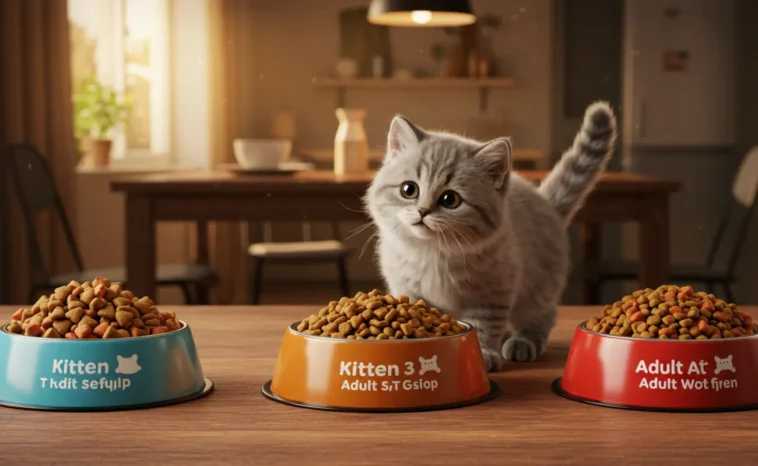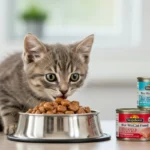Bringing a kitten into your home means ensuring they receive the right nutrition to grow into a healthy adult cat. However, as your kitten matures, you’ll need to switch them from kitten food to adult cat food. How to transition your kitten to adult cat food is a crucial process that requires a gradual shift to prevent digestive issues and nutritional deficiencies. In this article, we’ll walk you through everything you need to know about this transition, from the best time to switch to practical tips for making the process smooth for your feline friend.
Overview
Kittens require a specialized diet rich in protein, fats, and essential nutrients to support their rapid growth. But as they approach adulthood, their nutritional needs change, and they require a balanced adult cat diet. The transition should be slow and controlled to avoid digestive upset or refusal to eat.
This guide will cover:
- The right time to transition
- Steps for a smooth transition
- Common concerns and how to address them
- Benefits of adult cat food
- Expert recommendations on feline nutrition
When Should You Transition Your Kitten to Adult Cat Food?
Most veterinarians recommend transitioning your kitten to adult cat food between 12 to 14 months of age. However, for larger breeds like Maine Coons, this period might extend up to 18 months due to their prolonged growth phase.
Here are some signs that indicate your kitten is ready for adult food:
- They have reached their full size or are nearing it.
- Their energy levels have stabilized compared to their hyperactive kitten phase.
- Their weight gain has slowed down.
- They show less interest in frequent meals.
Step-by-Step Guide to Transitioning Your Kitten to Adult Cat Food
Step 1: Choose the Right Adult Cat Food
When selecting adult cat food, look for a high-quality option that meets the following criteria:
- Contains real animal protein as the primary ingredient
- Includes essential vitamins and minerals
- Has taurine for heart and eye health
- Free from artificial additives and fillers
Step 2: Gradually Mix Adult Cat Food with Kitten Food
A sudden diet change can lead to digestive issues such as diarrhea and vomiting. Instead, follow this 7–10-day transition plan:
- Day 1-2: 75% kitten food + 25% adult cat food
- Day 3-4: 50% kitten food + 50% adult cat food
- Day 5-6: 25% kitten food + 75% adult cat food
- Day 7-10: 100% adult cat food
If your kitten resists the change, extend the transition period until they adjust comfortably.
Step 3: Monitor Their Reaction
Pay attention to your cat’s:
- Digestive health: Look out for diarrhea, vomiting, or constipation.
- Appetite: If they refuse to eat, slow down the transition.
- Energy levels: Ensure they remain active and playful.
If any severe issues arise, consult your veterinarian.
Common Questions About Transitioning to Adult Cat Food
1. What if my kitten refuses to eat adult cat food?
Try mixing a small amount of wet food or a broth with the adult food to enhance its taste. Gradually reduce the extras as they get used to the new diet.
2. Can I switch to adult food overnight?
No. A sudden switch can cause digestive upset and rejection. A gradual transition ensures a smoother adjustment.
3. Is wet food or dry food better for adult cats?
Both have benefits:
- Dry food helps maintain dental health and is convenient.
- Wet food provides hydration and is easier to digest.
A combination of both is ideal for a balanced diet.
Challenges and Solutions Related to Transitioning
1. Digestive Issues
- Solution: Slow down the transition and introduce probiotics if necessary.
2. Picky Eaters
- Solution: Warm the food slightly or mix in a small amount of wet food.
3. Weight Management
- Solution: Measure portions properly and avoid overfeeding.
Benefits of Adult Cat Food
Switching to adult cat food offers numerous benefits, including:
- Balanced nutrition tailored for maintenance rather than growth.
- Better weight control as adult food has fewer calories than kitten food.
- Improved digestion with formulas designed for mature stomachs.
- Healthier coat and skin with essential fatty acids and vitamins.
Expert Opinions on Feline Nutrition
Veterinary experts suggest choosing AAFCO-approved cat food that provides complete and balanced nutrition. Dr. Sarah Mitchell, a feline nutritionist, emphasizes that a slow transition and high-quality ingredients are key to long-term feline health.
Frequently Asked Questions (FAQ)
Q1: What if my kitten eats adult cat food before 12 months?
Occasionally eating adult food won’t harm them, but prolonged feeding may lead to nutrient deficiencies.
Q2: Can I continue feeding my adult cat kitten food?
Kitten food is too calorie-dense for adult cats and can lead to obesity if fed long-term.
Q3: How do I know if my cat likes their new food?
Observe their eating habits and energy levels. If they eat consistently and show no digestive issues, they’re adapting well.
Conclusion & Call-to-Action
Transitioning your kitten to adult cat food is an important step in ensuring their long-term health and well-being. By gradually introducing new food, monitoring their reaction, and choosing high-quality nutrition, you can make the process smooth and stress-free.
Have you recently transitioned your kitten to adult cat food? Share your experience in the comments below or explore more Best Wet Cat Food for Kittens!






One Comment
Leave a ReplyOne Ping
Pingback:Best Wet Cat Food for Kittens (2025): Expert Reviews & Buying Guide